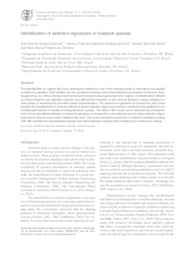Identification of selection signatures in livestock species.
Identification of selection signatures in livestock species.
Autoria: GOUVEIA, J. J. de S.; SILVA, M. V. G. B.; PAIVA, S. R.; OLIVEIRA, S. M. P. de
Resumo: The identification of regions that have undergone selection is one of the principal goals of theoretical and applied evolutionary genetics. Such studies can also provide information about the evolutionary processes involved in shaping genomes, as well as physical and functional information about genes/genomic regions. Domestication followed by breed formation and selection schemes has allowed the formation of very diverse livestock breeds adapted to a wide variety of environments and with special characteristics. The advances in genomics in the last five years have enabled the development of several methods to detect selection signatures and have resulted in the publication of a considerable number of studies involving livestock species. The aims of this review are to describe the principal effects of natural/artificial selection on livestock genomes, to present the main methods used to detect selection signatures and to discuss some recent results in this area. This review should be useful also to research scientists working with wild animals/non-domesticated species and plant biologists working with breeding and evolutionary biology.
Ano de publicação: 2014
Tipo de publicação: Artigo de periódico
Unidade: Embrapa Gado de Leite
Palavras-chave: Selective sweep, artificial selection, domestic animals
Observações
1 - Por padrão são exibidas publicações dos últimos 20 anos. Para encontrar publicações mais antigas, configure o filtro ano de publicação, colocando o ano a partir do qual você deseja encontrar publicações. O filtro está na coluna da esquerda na busca acima.
2 - Para ler algumas publicações da Embrapa (apenas as que estão em formato ePub), é necessário ter, no celular ou computador, um desses softwares gratuitos. Sistemas Android: Google Play Livros; IOS: iBooks; Windows e Linux: software Calibre.
Acesse outras publicações
Acesse a Base de Dados da Pesquisa Agropecuária (BDPA) para consultar o acervo completo das bibliotecas da Embrapa.

